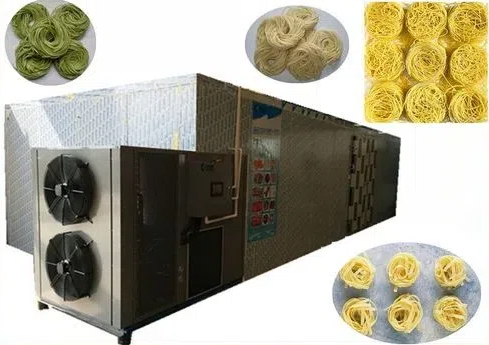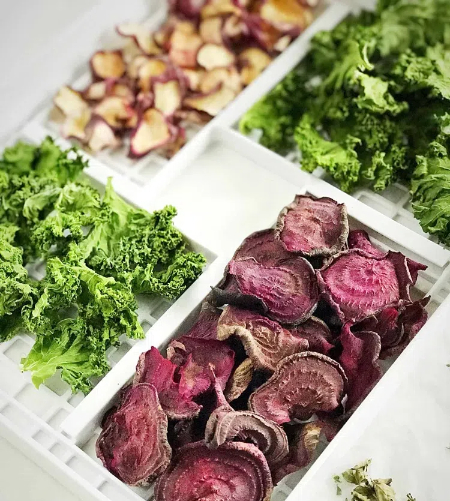
Content Menu
● Understanding Vegetable Dehydration Machines
● Key Features to Consider
>> 1. Temperature Control
>> 2. Capacity
>> 3. Airflow Type
>> 4. Ease of Cleaning
>> 5. Timer
>> 6. Material
● Types of Vegetable Dehydration Machines
>> 1. Heat Pump Dehydrators
>> 2. Mesh Belt Continuous Dehydrators
>> 3. Vertical Stack Dehydrators
>> 4. Horizontal Cabinet Dehydrators
● Additional Factors to Consider
>> 1. Noise Levels
>> 2. Energy Efficiency
>> 3. Versatility
>> 4. Warranty and Support
● Popular Models
>> Nesco Snackmaster Pro
>> Excalibur 9-Tray
>> Tribest Sedona Digital Dehydrator
● Step-by-Step Guide to Choosing a Machine
● Conclusion
● FAQs
>> 1. What is the ideal temperature range for dehydrating vegetables?
>> 2. How long does it take to dehydrate vegetables?
>> 3. Are vegetable dehydration machines expensive to run?
>> 4. Can I use oils when dehydrating vegetables?
>> 5. How do I prevent vegetables from sticking to trays?
● Citations:
Vegetable dehydration machines are essential tools for preserving food, reducing waste, and creating healthy snacks. With various models available, selecting the right machine can be overwhelming. This guide will help you understand the features to look for, the types of machines available, and how to choose the best vegetable dehydration machine for your needs.

Understanding Vegetable Dehydration Machines
Vegetable dehydration machines work by removing moisture from vegetables through controlled heat and airflow. This process extends shelf life, preserves nutrients, and allows you to create versatile dried products like chips, powders, or soups. The key components include:
- Heating Element: Generates heat to dry vegetables.
- Fan: Circulates air evenly across trays.
- Trays: Hold vegetables during dehydration.
- Temperature Control: Ensures optimal drying conditions for various vegetables.
Dehydrated vegetables retain their nutritional value while becoming lightweight and easy to store. They are ideal for long-term storage, outdoor adventures, or use in recipes that require dried ingredients.
Key Features to Consider
1. Temperature Control
Different vegetables require specific drying temperatures. Machines with adjustable temperature settings (e.g., 95°F–165°F) allow precision control for optimal results. For instance:
- Leafy greens like kale dry best at lower temperatures (95°F–115°F) to prevent nutrient loss.
- Root vegetables like carrots or potatoes require higher settings (125°F–135°F) for effective moisture removal.
2. Capacity
Consider the number of trays and total drying area. Larger machines with multiple trays are ideal for bulk processing, while smaller units suit occasional use. If you plan to dehydrate large quantities of vegetables regularly, opt for a machine with expandable tray options.
3. Airflow Type
Dehydrators come in two designs:
- Horizontal Airflow: Fans and heating elements are located at the back or side, ensuring even drying without flavor mixing. These are suitable for professional use or when drying a variety of foods simultaneously.
- Vertical Airflow: Fans are at the top or bottom; these are compact but may require tray rotation for uniform drying. They are more affordable and perfect for beginners.
4. Ease of Cleaning
Look for removable and dishwasher-safe trays to simplify maintenance. Cleaning is especially important when dehydrating sticky or juicy vegetables like tomatoes or bell peppers.
5. Timer
A built-in timer ensures consistent drying and prevents over-drying, maintaining food quality. Some advanced models also feature automatic shut-off functions for added convenience.
6. Material
Choose between BPA-free plastic trays for affordability or stainless steel trays for durability and aesthetics. Stainless steel models are often preferred in commercial settings due to their robustness.

Types of Vegetable Dehydration Machines
Understanding the different types of vegetable dehydration machines can help you make an informed decision based on your needs:
1. Heat Pump Dehydrators
These machines use air energy as a heat source and offer uniform drying with eco-friendly operation. Suitable for large-scale production, they are energy-efficient and capable of handling high volumes of vegetables.
2. Mesh Belt Continuous Dehydrators
Designed for industrial use, these machines feature multi-layer conveyor belts for continuous drying cycles. They are ideal for food manufacturers who need consistent output and high efficiency.
3. Vertical Stack Dehydrators
Compact and affordable, these models are perfect for home use but may require manual tray rotation to ensure even drying. They are lightweight and easy to store when not in use.
4. Horizontal Cabinet Dehydrators
Ideal for even drying without tray rotation, these models are preferred by professionals and serious home users alike. Horizontal airflow ensures uniform results across all trays.
Additional Factors to Consider
When choosing the best vegetable dehydration machine, there are a few additional factors that can impact your decision:
1. Noise Levels
Some dehydrators operate quietly, while others produce noticeable noise due to their fans and motors. If you plan to run the machine overnight or in shared spaces, consider a model with low noise output.
2. Energy Efficiency
Energy-efficient models not only save on electricity bills but also reduce environmental impact. Look for machines with energy-saving features such as automatic shut-off or low-wattage operation.
3. Versatility
Some vegetable dehydration machines can handle more than just vegetables—they can also dry fruits, herbs, meats (for jerky), or even make yogurt! If versatility is important to you, choose a multi-purpose model.
4. Warranty and Support
Check the warranty period offered by the manufacturer as well as customer support availability. A reliable warranty ensures peace of mind in case of defects or malfunctions.
Popular Models
Here are some popular vegetable dehydration machines that cater to different needs:
Nesco Snackmaster Pro
- Affordable and expandable up to 12 trays.
- Adjustable temperature (95°F–160°F).
- Compact design suitable for small kitchens.
Excalibur 9-Tray
- Large capacity with horizontal airflow.
- 26-hour timer and automatic shut-off.
- Ideal for serious home users or small-scale businesses.
Tribest Sedona Digital Dehydrator
- High-end model with adjustable temperature (77°F–167°F).
- Whisper-quiet operation and dual fan technology.
- Sleek design perfect for modern kitchens.
Step-by-Step Guide to Choosing a Machine
Follow these steps to find the best vegetable dehydration machine:
1. Assess Your Needs
Determine whether you need a machine for home use or industrial purposes.
2. Set a Budget
Prices range from $50 to over $300 depending on features and capacity.
3. Evaluate Features
Prioritize temperature control, capacity, ease of cleaning, and additional features like timers or noise levels.
4. Read Reviews
Check user feedback on reliability, performance, and customer service from manufacturers.
5. Test Before Buying (if possible)
If you have access to a local store that sells dehydrators, test different models before making your purchase decision.
Conclusion
Choosing the best vegetable dehydration machine depends on your specific needs, including capacity, features, and budget. Whether you're a home user looking to preserve seasonal produce or an industrial producer aiming to meet high demands, investing in a high-quality dehydrator ensures efficient preservation of vegetables while retaining their nutritional value.
By understanding key features such as temperature control, airflow type, capacity, and ease of cleaning—and considering additional factors like noise levels and energy efficiency—you can confidently select the right machine that suits your requirements.

FAQs
1. What is the ideal temperature range for dehydrating vegetables?
Most vegetables require temperatures between 125°F–135°F to dry effectively while preserving nutrients. However, delicate greens may need lower temperatures (95°F–115°F).
2. How long does it take to dehydrate vegetables?
Dehydration times vary by vegetable type and machine settings; it typically takes 4–10 hours depending on moisture content. For example:
- Leafy greens: 4–6 hours
- Root vegetables: 6–10 hours
3. Are vegetable dehydration machines expensive to run?
Energy consumption depends on wattage and local electricity rates; most machines are cost-efficient due to their low power usage. A typical dehydrator uses about 300–600 watts per hour.
4. Can I use oils when dehydrating vegetables?
Oils can be used lightly when preparing snacks like vegetable chips but should be avoided for long-term storage as they may go rancid over time.
5. How do I prevent vegetables from sticking to trays?
Use silicone fruit leather trays or parchment paper to prevent sticking during dehydration. Lightly spraying trays with non-stick cooking spray can also help.
Citations:
[1] https://thruhikers.co/dehydrators/
[2] https://littlegreendot.com/dehydrator-buying-guide/
[3] https://septree.com/blogs/news/dehydration-machines-101-the-essential-tool-for-food-lovers
[4] https://www.discountjuicers.com/dehydratingtimes.html
[5] https://www.youtube.com/watch?v=Ny6tGbu2nQ0
[6] https://www.bxdryer.com/news/industry-news/how-food-dehydrator-works-news.html
[7] https://www.linkedin.com/pulse/common-questions-food-dehydrators-aradmachinery
[8] https://www.thespruceeats.com/best-food-dehydrators-4077285
[9] https://www.istockphoto.com/photos/food-dehydrator
[10] https://www.youtube.com/watch?v=O7zPXmrPM4k
[11] https://excaliburdehydrator.com/pages/faqs
[12] https://www.thepurposefulpantry.com/dehydrating-faq/
[13] https://www.ukjuicers.com/dehydrator-faqs-a603
[14] https://airtekdehydrator.com/blog/purchasing-commercial-vegetable-drying-machine/
[15] https://www.foodandwine.com/lifestyle/kitchen/best-food-dehydrators
[16] https://www.webstaurantstore.com/guide/741/food-dehydrators-buying-guide.html
[17] https://www.gettystewart.com/dehydrating-equipment-what-you-need-to-get-started/
[18] https://www.seriouseats.com/best-food-dehydrators-5216308
[19] https://extremewellnesssupply.com/blogs/news/how-does-a-dehydrator-work
[20] https://www.youtube.com/watch?v=rR2G5UO-5Ms
[21] https://excaliburdehydrator.com
[22] https://www.youtube.com/watch?v=A184G3vTk8M
[23] https://www.hachettebookgroup.com/storey/dehydrating-faqs-and-answers-for-beginners/
[24] https://backpackinglight.com/forums/topic/20324/
[25] https://www.aromaco.com/faq/food-dehydrators/
[26] https://www.youtube.com/watch?v=JXcXfGCWIyQ
[27] https://pleasanthillgrain.com/resources/dehydrators-buying-guide
[28] https://www.istockphoto.com/photos/vegetable-dryer
[29] https://www.youtube.com/watch?v=mtDzdYoyeR8
[30] https://www.dehydratorsamerica.com/category/industrial-food-dehydrators
[31] https://harvestright.com/v50/
[32] https://www.youtube.com/watch?v=tWcw1WOSVv4











